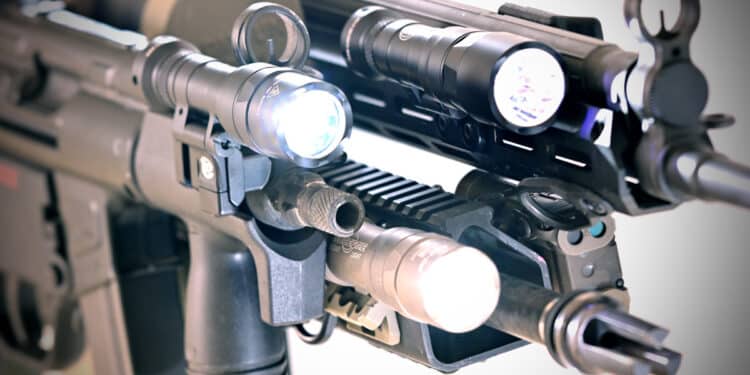By Alton Chiu
A race car goes fast but cannot take your children to school. A flight-certified computer supports a mission to Mars but cannot play Call of Duty. Different jobs require different tools; and tactical lights are no different.
CANDELA VS. LUMEN
Instead of choosing a light based on a single specification, be it candela or lumen, we should first understand the job. Do we need to search rooms and attics, long hallways, or someone sitting in a car with tinted windows? A flood beam provides even illumination across a wide angle and is best for situational awareness. A spot beam concentrates light to project it farther, just as putting a thumb over a garden hose propels water farther.
Since there is no industry standard for describing beam pattern, we consumers are only left with bewildering marketing terms like “MaxVision”, “TLR”, and “Turbo”. Comparing across manufacturers can be even more daunting; but never fear, since a combination of candela and lumen specs describes a lot… if we understand their definitions.
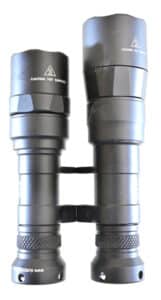
In very broad strokes, lumens are the raw material which the lens shapes into candela. A laser has high candela but low lumen because it is extremely bright at a very narrow angle. A bare lightbulb has low candela but high lumen because it evenly projects light everywhere. Neither is inherently good or bad; a light bulb cannot designate targets while a laser pointer cannot illuminate a room. The job determines which measurement is more important.
With lumen as the undirected output of the LED emitter, candela is the light projected in a specific direction. At a scientific level, candela varies from dead-ahead to the edge of the spill; that shape shows how tight the hotspot is. Unfortunately, marketing material usually oversimplifies that into a single number representing the peak hotspot. While it’s a stretch to call it misleading, this forces us to infer a beam pattern. However, we can still make an objective comparison in its ability to penetrate photonic barriers. Whether we are looking into a shadow caused by a streetlamp or defeating window tint, higher candela is better.
It’s trivial to say higher lumen is better, but reality is more nuanced due to size constraints. Just like how a V12 engine requires a large chassis, a large and high-output emitter requires a large lens to produce a spot beam. To achieve a reasonable size, manufacturers sacrifice lumen with smaller emitters. Even then, accompanying photos show the spot patterned SureFire M340DFT Turbo has a wider diameter and longer lens than its SureFire M340C cousin. The smaller LED of the Turbo is also reflected by the 350 vs. 500 lumens of the M340C when using CR123 batteries.
Now, let’s look at some real-world examples. The table below arranges lights from low candela (left) to high. SureFire’s M600DF has the highest lumen but the lowest candela, indicating a flood pattern. The Cloud Defensive REIN and Modlite PLHv2 have almost the same lumen as M600DF but significantly higher candela, hinting at a trade of spill for throw. The higher candela and lower lumen of the Modlite OKW indicates that a smaller emitter is used to further tighten the beam. Now knowing how to decipher these ratings, we can choose the best tool for the job.
| SureFire M600DF | Modlite PLHv2 | Cloud REIN | Modlite OKW | |
| Lumen | 1,500 | 1,350 | 1,400 | 680 |
| Candela | 16,000 | 54,000 | 60,000 | 71,000 |

PHOTONS DOWNRANGE
Since a picture is worth a thousand words, here are a few thousand words. All photos within each series are taken with the same exposure setting. Inside our garage, the spot-patterned 95000 candela M340DFT hotspot is so bright as to overexpose the wheels. With only 7600-candela, M340C widens the hotspot at the cost of brightness. Despite a raw output three times that of the M340, the 16000 candela M600DF spreads out that light to create an evenly lit scene that promotes situational awareness.
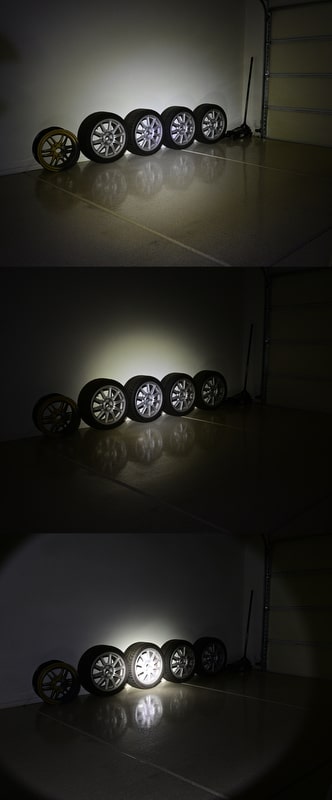
High candela is indispensable for pushing through vehicle window tint or projected light at a distance. Despite being only 150-lumen more, M340DFT could easily allow identification at 25m and into a tinted vehicle cabin. No pattern is inherently better or worse; mission dictates equipment.
BATTERIES

We prefer rechargeables for high performance, backed up by long shelf-life primary cells. As we dive deeper, a lack of standardization bewilders consumers and can potentially lead to unsafe choices.
First, we shall dive into the fuel that powers our lights. Until recently, most lights were powered by primary (non-rechargeable) CR123 cells; their high drain delivers high lumens. These cells have a long shelf life, with SureFire and Streamlight branded batteries advertising a 10-year shelf-life. 18650 and 18630 rechargeable batteries support even higher drain, and high-performance lights have migrated to using these. SureFire exploited this on its M600DF to deliver 1500 lumens with an 18650 while producing only 1000 lumen with CR123s. Another unfortunate lack of standard terminology haunts consumers, as all “dual fuel” SureFire products use both rechargeable and primary cells while such Modlite products use both 18650 and 18350. In fact, Modlite have separate heads for rechargeable (OKW and PHLv2) and primary cells (Legacy LED-T and LED-F). So, while heads can move between different sized bodies, you cannot use long shelf-life primary cells as backups in the field. For this reason, we prefer SureFire’s interpretation of dual fuel.
Despite performance advantages, rechargeables do have pitfalls. Rechargeable CR123s can reach voltages much higher than the 3V of primary cell and damage electronics; SureFire recommends only using their branded cells for this reason. RCR123s also have lower capacity compared to primary cells; SureFire branded rechargeables only have 450mAh compared to 1550mAh of primaries. For 18650 and 18350, some cells handle protection against abuses like over-charging, over-discharging, and reverse polarity. Using non-approved cells can remove such protection and lead to fires. Not all batteries are created equal, so we recommend following manufacturer recommendations.
FORM FACTOR
Firearm accessories are like Barbies for men. Sometimes, there is no telling whether a handbag goes with a dress until you put everything together, and there is no telling whether a light fits ergonomically until you put it into service.
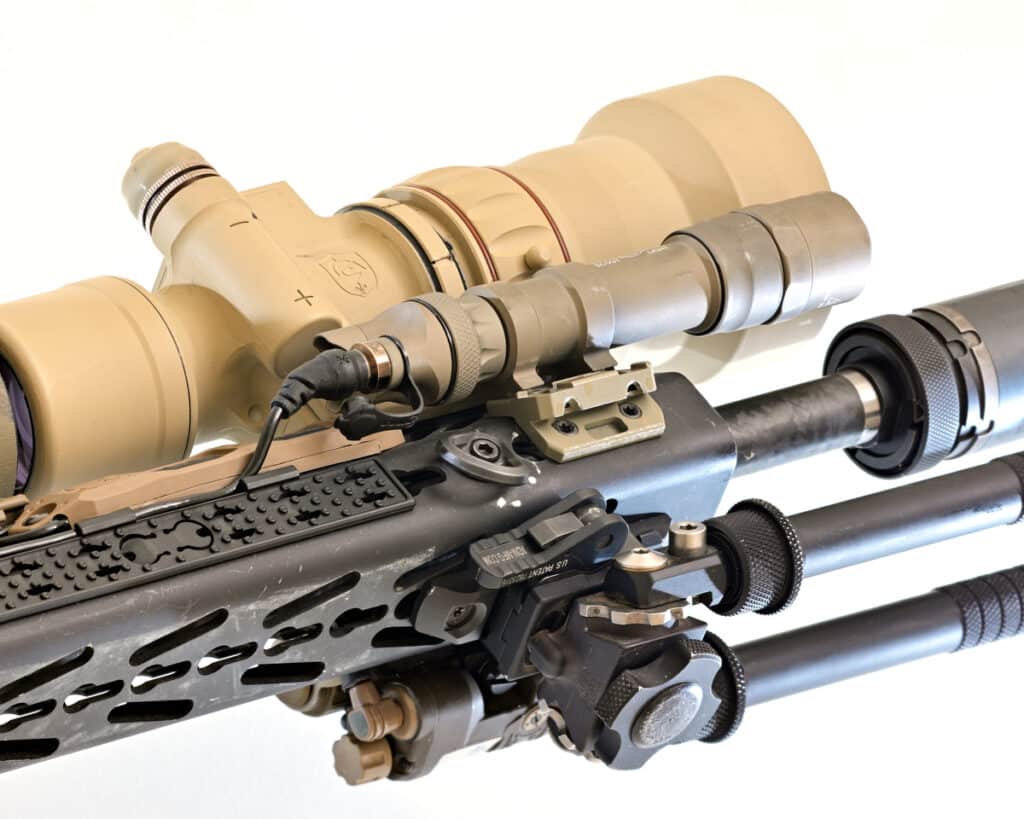
For example, the need to mount a clip-on night vision device forced our laser aiming device to the side and necessitated a tape switch for ergonomic activation. Said tape switch pushed the light too close the muzzle. While a single cell light (e.g., SureFire M340) would mitigate muzzle blast concerns, we ultimately decided the reduced output and restricted situational awareness was not acceptable. There was no predicting the interference until we assembled everything.
To combat that unpredictability, SureFire Pro series lights pivot around the mount for ergonomic positioning and accommodate different handguards or laser devices. Traditionally, lights mount atop Picatinny rail sections and require aftermarket mounts for vertical or lateral offset. Different mounts are required for different positioning. The SureFire Pro provides an OEM solution that can mount directly to M-LOK and is hinged for infinitely adjustable offsets. Bobro Engineering’s pivoting mount (BM2-FP-000-003) upgrades legacy SureFire style bodies to have the same capabilities. This flexibility prevents the spare parts bin from expanding during the quest for ergonomic compatibility.
SWITCHOLOGY
Activation mechanism is another vital ergonomic piece. Switches fall into either momentary-only or constant-on (aka, “clicky”). Lightly press with a clicky gives momentary-on, while a firm push ‘till a click activates constant-on. SureFire only ships weapon lights with a clicky tailcap, but Arisaka Defense offers an aftermarket momentary-only replacement.
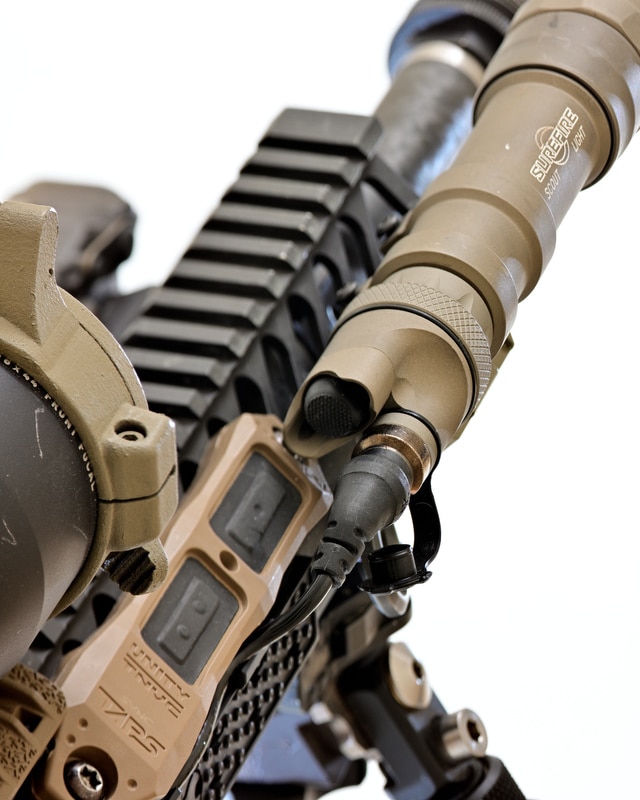
Remotely mounted tape switches allow you to ergonomically fire the light or laser when the units are forced to suboptimal locations by other accessories, or to utilize the visible override feature on lasers. Beware that some tape switches only support SureFire leads; the Streamlight Protac HL-X requires a tailcap adapter, and the Cloud Defensive OWL cannot accept any aftermarket tape switch at all. Mirroring tailcaps, light activation for the Modlite ModButton and the Unity TAPS are momentary-only while the Unity Hot Button and the Unity AXON are clicky.
There is no wrong choice as long as you can maintain light discipline. At home, with a clicky switch, we had no problems modulating pressure to select momentary activation. During class with some adrenaline, we mashed the button and accidentally selected constant-on while thinking we were momentary-only. This lack of light discipline caused us to backlight ourselves during a rifle-to-pistol transition drill. Our lesson learned was to use a momentary-only tape switch along with a DS00 tailcap to maintain the constant-on option. We found the latter useful for relieving finger strain while holding a light on a hallway for long periods. The goal is to maintain light discipline, equipment just makes that easier.
CONCLUSION
You should not select a light based on a single specification. The job dictates the ideal beam pattern while ancillary concerns such as battery and form factor considerations also play a part. Understanding concepts like candela and lumen helps us cut through confusion caused by marketing terms. Until we get wearables with augmented reality exploiting other spectrums, we must augment our vision with photons the best we can.



